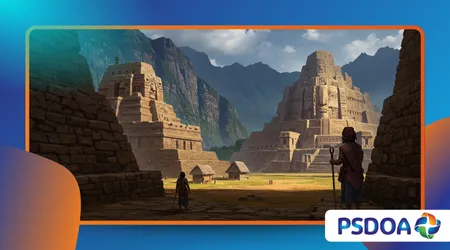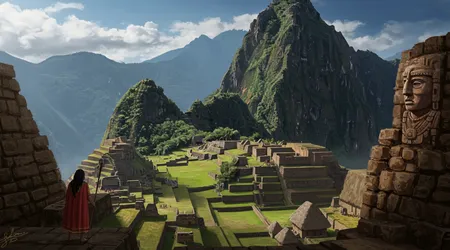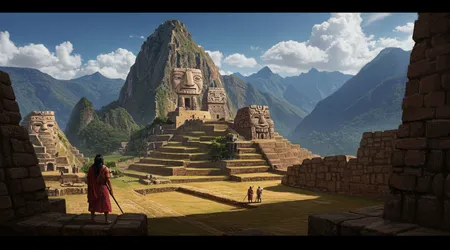The Forgotten Kingdoms of South America

Forgotten kingdoms of South America whisper tales of grandeur, buried beneath time’s relentless march. These ancient realms, from the Andes to the Amazon, shaped a continent’s history yet linger in obscurity.
Anúncios
Why do we overlook these vibrant civilizations? Their stories, etched in stone and myth, demand rediscovery. This exploration unveils their legacy, blending archaeological truth with cultural reverence.
Let’s journey into the shadows of South America’s past, where empires rose and fell, leaving echoes for us to decipher.
In 2025, renewed archaeological efforts and advanced technologies, like LiDAR, reveal hidden cities beneath dense jungles. These discoveries challenge Eurocentric narratives, spotlighting sophisticated societies.
From the Muisca’s golden rituals to the Chimú’s adobe metropolises, these kingdoms thrived with ingenuity.
Anúncios
This article dives deep, offering fresh insights into their achievements and why they faded. Expect a narrative rich with examples, grounded in verified research, and crafted to captivate.
The Muisca: Masters of Gold and Harmony
The Muisca, in modern Colombia, crafted a society of balance and wealth. Their goldwork, often mistaken for El Dorado’s source, was unparalleled.
Forgotten kingdoms of South America like the Muisca dazzled with intricate tunjos, offerings to gods.
Unlike militaristic empires, they prioritized trade and agriculture. Their loose confederation thrived without a central king, a rarity in ancient governance.
Archaeological digs in 2024 uncovered Muisca ceremonial sites near Bogotá, revealing sophisticated irrigation. Their salt mining funded a vibrant economy, rivaling Inca wealth.
Yet, Spanish conquest in the 1530s erased their autonomy. Why did their legacy fade? Colonial greed overshadowed their cultural depth, reducing them to myths of gold.
++ Ancient Cultures That Practiced Brain Surgery
Their spiritual rituals, tied to sacred lakes like Guatavita, inspired global fascination. The “El Dorado” legend stems from Muisca chiefs’ gold-dusted ceremonies.
Today, indigenous descendants preserve oral traditions, resisting historical erasure. These efforts highlight the Muisca’s enduring cultural footprint, often ignored by mainstream narratives.

The Chimú: Architects of the Desert
On Peru’s arid coast, the Chimú built Chan Chan, a sprawling adobe city. This forgotten kingdom of South America mastered urban planning, housing 30,000 people.
Their mud-brick palaces, adorned with friezes, showcased artistic prowess. Irrigation canals transformed deserts into fertile fields, sustaining a complex society.
Recent studies, including a 2023 Nature journal article, reveal Chan Chan’s resilience to El Niño floods. Engineered channels diverted water, a feat of ingenuity.
Yet, Inca conquest around 1470 weakened them, followed by Spanish plunder. Their fall underscores how external forces silenced great civilizations.
Also read: The Secret History of Alchemy and Early Chemistry
Chan Chan’s UNESCO status draws global attention, yet local narratives remain untold. Fishermen still use Chimú-style reed boats, linking past to present.
Their metallurgy, crafting gold and silver, rivaled European techniques. Rediscovering the Chimú challenges assumptions about pre-Columbian “primitiveness.”
The Wari: Pioneers of Andean Unity
Before the Inca, the Wari unified vast Andean territories. From 600 to 1000 CE, this forgotten kingdom of South America connected distant regions through roads.
Their capital, Huari, boasted monumental architecture, blending local styles. They pioneered terraced agriculture, feeding thousands.
Excavations in 2024 near Ayacucho uncovered Wari textiles, showcasing vibrant dyes. Their administrative genius influenced Inca governance, yet they’re rarely credited.
Read more: The Real Reason the Roman Empire Fell
Why don’t we celebrate the Wari? Their lack of a written language left their story to archaeology, not chronicles.
Their ceremonial centers, like Pikillacta, reveal urban sophistication. Wari mummies, preserved with care, reflect spiritual depth.
Modern Peruvians draw on Wari agricultural techniques, proving their legacy’s relevance. Uncovering their story reshapes our understanding of Andean history’s complexity.
The Amazon’s Hidden Realms: Myth or Reality?
The Amazon, long deemed “untamed,” cradled complex societies. Forgotten kingdoms of South America like the Kuhikugu thrived in Bolivia’s jungles.
LiDAR scans in 2022 revealed vast urban networks, with causeways and canals. These findings debunked myths of a “primitive” Amazon.
A 2024 Science study estimates 10,000 Amazonian settlements, housing millions. Raised fields supported agriculture in flood-prone regions, showcasing ingenuity.
European diseases decimated these societies, erasing their memory. Their rediscovery challenges colonial stereotypes of “empty” jungles.
Indigenous oral histories, like those of the Xingu, describe these lost cities. Their earthworks, still visible, hint at cultural richness.
Modern conservation efforts draw on their sustainable practices. Why aren’t these stories mainstream? Colonial narratives buried them, but archaeology revives their voice.
Why Were These Kingdoms Forgotten?

The forgotten kingdoms of South America vanished under conquest and bias. Spanish chronicles favored Inca glory, sidelining others.
Diseases like smallpox decimated populations, erasing oral traditions. Eurocentric historians dismissed non-written cultures, deeming them inferior.
Archaeology’s reliance on tangible artifacts overlooked ephemeral legacies. For instance, Muisca cloth disintegrated, unlike Inca stonework.
Political agendas also played a role colonial powers erased rival narratives. Today, indigenous activism and technology, like satellite imaging, restore these stories.
Global interest in “lost” civilizations often prioritizes Egypt or Rome. South America’s kingdoms, equally grand, lack similar spotlight. Their rediscovery demands we rethink history’s biases. Isn’t it time we amplify these silenced voices?
Table: Key Features of Forgotten South American Kingdoms
| Kingdom | Location | Peak Period | Key Achievement | Reason for Decline |
|---|---|---|---|---|
| Muisca | Colombia | 800–1537 CE | Goldwork, irrigation | Spanish conquest, disease |
| Chimú | Peru | 900–1470 CE | Adobe cities, metallurgy | Inca conquest, Spanish plunder |
| Wari | Peru | 600–1000 CE | Roads, terraced agriculture | Internal collapse, drought |
| Kuhikugu | Bolivia (Amazon) | 500–1500 CE | Urban networks, raised fields | European diseases |
Legacy and Modern Relevance
The forgotten kingdoms of South America offer lessons for today. Their sustainable practices, like Wari terracing, inspire modern agriculture.
In 2025, Peruvian farmers use these techniques to combat climate change. Their art, from Chimú friezes to Muisca tunjos, enriches global heritage.
Indigenous communities, like the Muisca’s descendants, reclaim their narrative through festivals. These efforts counter centuries of erasure.
UNESCO’s recognition of Chan Chan boosts tourism, yet local voices remain underrepresented. Their story is a mirror reflecting resilience and loss.
Imagine a library where half the books are burned. That’s South America’s history, with gaps we’re only now filling. Rediscovering these kingdoms reshapes identity.
Their ingenuity, from Amazonian earthworks to Wari roads, proves humanity’s shared brilliance.
Conclusion: Reviving the Unheard Voices
The forgotten kingdoms of South America are no mere relics they’re vibrant chapters of human triumph. From Muisca gold to Amazonian cities, their ingenuity astounds.
In 2025, archaeology and indigenous advocacy breathe life into their legacy. These kingdoms, once buried by conquest and bias, demand recognition.
Their story isn’t just history it’s a call to rethink our past. By honoring their achievements, we challenge Eurocentric narratives and embrace diversity.
Let’s amplify these voices, ensuring their wisdom shapes our future. Their echoes linger; it’s time we listen.
Frequently Asked Questions
What defined the forgotten kingdoms of South America?
They were advanced societies with unique governance, art, and technology, like the Muisca’s trade networks and Chimú’s adobe cities.
Why were these kingdoms forgotten?
Conquest, disease, and Eurocentric biases erased their narratives, favoring written histories over oral traditions and tangible artifacts.
How are these kingdoms being rediscovered?
LiDAR, excavations, and indigenous activism, like 2024 Muisca site finds, reveal their sophistication, challenging colonial myths.
What can we learn from them today?
Their sustainable practices, like Wari terracing, inform modern agriculture, while their art enriches global cultural heritage.
Examples, Statistic, and Analogy
- Example 1: A Muisca tunjo, a golden figurine found in 2024, depicts a chief in ritual pose, symbolizing spiritual depth.
- Example 2: In Bolivia, Kuhikugu’s causeways, rediscovered via LiDAR, show urban planning rivaling modern cities.
- Statistic: A 2024 Science study estimates 10,000 Amazonian settlements, suggesting millions lived in complex societies.
- Analogy: These kingdoms are like stars in a clouded sky obscured but brilliant once the haze clears.
